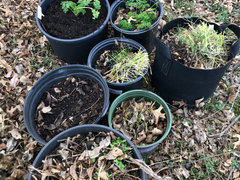January 2020, Week 5
Okiedawn OK Zone 7
4 years ago
Featured Answer
Sort by:Oldest
Comments (46)
dbarron
4 years agolast modified: 4 years agoRebecca (7a)
4 years agoRelated Discussions
January 2018, Week 2....The Week The Tomato Cravings Set In?
Comments (95)LOLOLOL. Doofus. No one was mean! Not at all. Just that they don't like folks going onto the site and doing something different. I can really actually see their point. It'd be different if I'd been winter-sowing for 5 years. It'd be like a brand new gardener coming into the FB forum and telling everyone they're going to plant their entire garden in hay bales. Or stuff like that, you know? What was a little exasperating was that some of them didn't read the post entirely and so it wasn't really a dialogue. No matter. All is good. But if they're mean again, I'll sic you onto them. ROTFL! AND, can't you find anything that contains collagen on a vegan diet?? (Not being vegan, I would not know that, you know.) Rebecca, I'm not as worried about them frying, I mean there are a ton of holes in them. Further, cross currents are usually more effective at bringing breezes through than from just one direction. I will say, that even had I put holes in the top, I still would have put holes in the sides, too. But. Okay tell you what. I'll go put a couple holes in the tops of some of them! LOL My larger concern is the bottom watering, just because I haven't seen anyone else doing it. I can't imagine why it won't work, since the indoor seedlings prefer bottom watering. But I'm still nervous about it. Could you please give me your thoughts on that? (Our first row of holes above the bottom is 1 1/2 inches high, which was exactly as much water as it took to dampen all the pots.) At any rate, yes, if I notice anything going awry, I'll spring into action to correct. I would say in Oklahoma ANYONE who WSes is in danger of frying the plants! We ALL need to keep our eyes on that possibility, right? But yes, with you working, you're not around to hover over them like I am. NOW. In the horrible event that I get called out of town for emergencies, I'll have to hire my nearby gardener friend! . . . Then I'd probably move everything closer in to the house for a minimal amount of sun. But then so would a lot of the rest of you be in trouble, too. Last year, I spent a good bit of time scooting my 15-gallon fabric container pots back closer to the house (and under the half roof on that part of the deck, either to get them out of the sun, or to protect them from the rains POURing down. I can certainly do that with the totes, too. Yes, Dawn. . . . Rebecca's cute little daisy was discussed in this article. I loved it and got a good laugh. http://dailyimprovisations.com/fun-flowers-to-grow-from-seed-cape-daisy-or-venidium-fastuosum This hybrid. . . . I think it'd be great to actually get even just a few seeds to see if any of them turn out to be true to the type--that would be very cool. If I live another 4 years, Dawn, I won't be winter-sowing anymore either, as I believe I'm growing everything I'll ever need to grow (perennial/herb/hardy annual-wise) this year. Hmmm. Who am I gonna unload these totes and pots on. Here I was thinking it was going to be one of those depreciation items. Perhaps not. . . .LOL Oh, Dawn, that is very upsetting about something scary out there. Please keep us posted. And along the subject of pets, I also would rather watch puppies OR kitties than almost anything. We are loving Tom and Jerry. . . even Titan is just fascinated. These guys certainly are not anything like Daffy. He sees possibilities with them being entertainment. But occasionally gets over-enthusiastic. He thinks it's fine for him to lunge at them as they race past him (and it's not, we tell him), but he is VERY touchy so far when one of them tries to attack his tail or foot. We think it's very funny of course, but he at least hasn't snapped at them, just kinda growled/woofed them off. That is VERY good on his part. Also when they would approach his dinner. . .THAT is his wild animal trigger response. We've worked and worked and worked with him on that one. We normally shut them in the cats' room (formerly the art room) to be eating their own dinner, but before we got wised up to that, they'd go over to HIS food dish--I almost got bit once, as did Garry once. There were severe penalties involved. Also a bratty 3-yr old liked to tease him with it--unfortunately, he was the one who paid--but so did she. So it was fairly miraculous that when the kittens tried to interfere, all he did was growl angrily and boy did they back off quickly. We're feeling very good about the kittens and Titan, they all three are fascinated with each other and full of good cheer. But Titan IS part wolf, after all, and we always are very aware of him--in unexpected situations. I am 100% certain GDW and I are gold with him. But I always keep an eye on him when he indicates he's uncomfortable with someone or a certain situation, and usually take him into the house then. The kittens are his first test situation with trust, and he's doing SUPER, but we still keep an eye on him. Little thinker, Tom, has now finally decided GDW is okay, too, and so now is landing on HIS lap and in HIS way. They're just precious, both of them. Kim, I missed your supportive post earlier, that was SO sweet!!! Thanks for believing in me--you KNOW I believe in you, too. You are a marvel! We're both kinda Ruth Stout people, I think. Ruth definitely figured out what worked for her and followed that path! But if the rumor Amy heard about Ruth is true, that she gardened naked, I know neither of US is gonna do that. I don't even like wearing short-sleeved T-shirts while gardening. Gardening is like full armor down here! Okay okay, I admit. Oklahoma gardening is not easy!!! It's the damn bugs!!! The critters! The aphids, the bad beetles, the slugs, the ticks, the chiggers, the fleas, the voles, the gophers. .............................................. a person in OK would have to be insane to be gardening in their shorts and tank tops and flip-flops and bare-handed, in my opinion! Let alone naked. Amy and Eileen, tomorrow our trip to Broken Arrow. Our whole day affair. Short notice, so maybe we can actually plan the next trip. But if you can meet up, let me know. However, Amy has a good point--will have more seeds if we meet up in a couple more weeks--maybe we should start talking about that--the seeds we have to give. Aldi, then back through Wagoner for buttermilk and candles, and then back home. We have been SO hunkered down here. And you guys who are so tired of winter? We are, too, of course, but you know what? I've made my peace with it, somehow. I wasn't allowed to hunker down in MN or WY, working every day all through the winter nonsense. It was COLD. Not easy, especially with vehicles. Those of us smart ones (sometimes I was smart, sometimes not so much so) had engine heaters for the cars plugged in for overnight. When I lived with my son and his family in Mpls, we had a street-level garage, but the rest of the property sloped steeply up. When it snowed, we'd have great fun the first few snows in December; partying out there in the driveway--with the snowblower and the others using shovels. By February or earlier when the drifts next to the driveway were up to 5-6 feet, not so much fun. It was so MUCH colder and more brittle and so much dryer in WY and MN in the winter. But I don't care. It's COLD here. I'm with the rest of ya. I used to trot out on my patio in Mpls when it was -10, in my short nightgown, for a last cigarette. It's all just so weird! Well, HJ, speaking of rambling!...See MoreWeek 5, January 2018: One Month Ends, Another Begins...and a blue moon
Comments (93)Patti, yes, I guess a leaky heart should be looked into. And loved your approach to the doctor! Way to go! You must be SO proud of your SIL and that whole family! That's doggoned impressive! And thrilled for your son and getting his bride-to-be back here, a little nervous about her getting in without any glitches. Exciting times for you! Does she speak Mandarin?? What part of China is she from? I just did cart seeds inside for the first time last year. It was surprisingly easy with the good help of all our smart friends here. They were even more help advising where and when and what to plant and filling the raised beds. Last year, I had no idea how to tell what I wanted in a tomato or pepper (or anything else--I'm sure you all remember my ignorance); I have learned so much from you all in the past year; and I had to laugh at Rebecca saying that she bet I wouldn't buy seed from (I don't know who it was, some big box company). And it IS true that I've become very uppity about seed companies--but it's all y'all's fault! You know it is. I didn't get started on seed-planting today, Dawn. Maybe tomorrow. We are still staying away from: church, and schools. So maybe I'll get up and begin tending the garden for God. :) I'm a little bit freaked about IT, too. I bet all of you who have only recently started all the seed-growing stuff are feeling about like I am. . . So technically, this is only my second year. But it was so easy last year, I'm not too freaked out. Mostly by the nightmares of potting up, the taking all those flats out every morning, bringing them all back in in the evenings. Too funny. It's like running an orphanage, pet shelter, daycare. Constant attention, right? I'm thrilled that in what is going into my 4th year here, I have SO many perennials, self-seeding annuals, and shrubs going. SO appreciated the additional info on drip irrigation tubing. I'm still on the edge, there. I think I will maybe NOT do it in the flower beds, cept for the cement block raised one, and the raised veggie beds. Maybe soaker hoses, though. I really don't much care about the worry over sprinklers getting leaves wet, when I remember the 20" of rain we got May into July for two years in a row. The saving money part, sure. But I have those oscillating sprinklers, so can narrow down the watering to the immediate bed being watered. That's gotta help some. HJ and Dawn both posted while I was starting on this, so had to change windows to see what they had to say. lol Liked the way you tied Rh into gardening, HJ. Very creative. And now, HJ, and I am very worried about your babies since dogs seem to be about. (Which is one of the two main reasons we won't have them--the other being times we have to go to Wy or Mn.) Amy, I had to google the car accident you mentioned. How very sad. They still haven't released the names. We only go to Wahoo Bay occasionally, because you know my distaste for traveling. It's probably 25-30 miles from our house--as you know, we're north and east of Wagoner by 10 miles; Wahoo is south and east of Wagoner by about 15. We go down there a couple times each summer. Actually, that's where GDW is going to crappie fish--a nice heated dock not too far north of Wahoo. And he is on a mission now. We got his moon jigs, his special bobbers should be showing up Tuesday, and then he just KNOWs he'll be catching all kinds of crappies. That was funny, you mentioning your Mom ears. I have them, too, with the new kitties. Speaking of them. . . . uh oh, I fear they are into their teens, full blown. Jerry's actually the troublemaker; but Tom is the dangerously funny one. They were both obsessed with getting into the pantry, because of the hole in the wall where the water lines are. But mostly because it's a shut door. If a door is shut, that's where they want to go. Garry fixed the door once (previously it shut and stayed shut, but didn't latch.) But didn't fix it good enough apparently. Last night, one of the cats came racing in here with a prize--my brand new fancy dancy fuzzy "feather duster." Score!, he thought, and you could all but see them doing "high 5's" about it. All I could do was laugh. The fuzzy part is a foot long, and then has a wood handle that's another foot long. Hysterical. So I put it back and shut the door. This morning before I was up, GDW got to witness the same thing. But so, he FIXED the door good today. The cats are so ticked off. BUT, now, I fear the cabinets are next, as Tom was interested in seeing in what was one of them when I opened it today. . . and they, of course, do not latch. You could almost see the little light bulbs going off in his head. They've been rowdy today. . . SO rowdy. So funny. They're both also SO affectionate. I plunked Tom down 4 times earlier today when he was being obnoxious and in my face (AFTER I gave him 15 minutes of uninterrupted time), and four times he jumped back instantly. But he also has been in either GDW's lap or mine every time we have sat down today....See MoreJanuary 2020, Week 3
Comments (50)I just got my first set of stainless steel straws. I like them so far, but there’s the transportation problem. I don’t usually carry a purse anymore, unless I’m out all day or will need to carry storage. I just grab my billfold and phone. Straws don’t fit all the way. Going to have to think on that one. Also, some of Audrey’s favorite toys are the red plastic straws from QT and Sonic. Amy, I still buy powdered detergent. I think it works better than liquid and doesn‘t gunk up the washer. Walmart and Target have Tide, Cheer, and Gain powders. Sometimes I pick up Ariel at the Mexican market. Mom used Cheer powder exclusively when I was growing up, so it invokes good memories here. I also use only hot water, because cold water doesn’t get anything clean. If it did, our dishwashers would run on cold water, and we’d shower in it. Nope, I’ll stick with hot. Grimy gardening clothes, you know. I‘m a terrible housekeeper, but I do like vinegar for cleaning. It also works well in the rinse aid dispenser in the dishwasher. I need my paper towels for cleaning up cat barf, and when she commits insecticide. I have major issues with cleaning up anything yucky with regular towels. Same with Kleenex. And toilet paper, actually. All messy, gross stuff should be disposable. I was making progress in avoiding plastic bags until last fall. I have plenty of reusable containers. I try to avoid containers that aren’t reusable or recyclable. I recycle a lot. I even recycle my winter sowing containers after they become too brittle to use. Audrey likes Arm and Hammer litter that comes in cardboard boxes, so I recycle those too. Although, I often wish I had the plastic buckets for planting. I tried the recycled, green, environmentally proper litter, and all of my cats over the years have rather dramatically rejected it. Gardening: I have milkweed seeds in the freezer and I miss tomatoes....See MoreJanuary 2020, Week 4
Comments (48)So, I'm back now to read thoroughly and try to respond. Amy, I do treat lima beans pretty much like snap beans except for planting them slightly later since they are heat lovers and I'm using them to fill that legume role after the snap beans are pretty much done. I have tried planting lima beans at the same time as snap beans, and in my location it doesn't work out well. Maybe that's our cool spring microclimate getting a bit colder at night than the lima beans like or something, so I tend to plant them about a month or six weeks after snap beans. However, I plant snap beans sort of on the early side to beat the heat and the spider mites, so maybe the limas just don't tolerate being planted too early as well as the snap beans do. One thing I do ponder is this: if I have snap beans, the spider mites are going to show up on them...sometimes insanely early. Why, then, do the spider mites not bother the lima beans at all? Beans are beans, right? I wonder if anyone has researched this. We are not big fans of celeriac either. We have tried it, but about the only way I use it nowadays is chopped up in a big pot of vegetable soup. I don't blame you for being mad at Wal-mart. Ours never has enough electric carts for all the folks who need them, and they've taken out the benches they used to have at the front of the store. I guess the benches got in the way of one of the little banks, or the vet, or the hair salon or whatever that now populates the front of the store outside the checkouts. I fight the blahs in dreary, cloudy winter weather too. I need sunshine! This winter has been tougher than most because the sun has been hiding behind the clouds almost every day, and often (I blame the warmer temperatures for this) we have had fog until noon. I feel like we've sort of had Pacific Northwest weather this year with all the incessant fog, mist, clouds and drizzle and I have not liked it at all. Jennifer, In my garden, beans as a group are relatively pest free, except that the spider mites really love them. Some years the mites arrive early and are horrible, and other years the beans pretty much finish producing before any spider mites arrive at all. You might see occasional damage from Mexican bean beetles. I will see a little of that here and there, but not enough to worry about. Some years, if there is a heavy population of stink bugs (like we had last year), they will be on the beans. I have noticed that southern green stink bugs are more of a pest on beans than the brown stink bugs are. I run across the green stink bugs on the plants when harvesting beans so I try to always have my garden scissors with me so I can snip those stink bugs in half. (Don't squish stink bugs with your bare fingers unless you want for your fingers to stink all day long, even after you have thoroughly washed them.) Because you have coyotes in your neighborhood, I would not have a miniature cow unless I also had a guardian livestock dog (like a Great Pyrenees, for example) to protect the cow from the coyotes. Or, maybe a donkey. Donkeys are great at protecting livestock as well and even will take on large dogs and cougars to protect their herd. Okmulgeeboy, I have grown a gazillion types of beans over the years. There are hundreds of varieties available commercially and it has been fun to experiment with all the different kinds. If a person is going to binge on something in the garden, beans are a fun crop to experiment with. I do not grow dry beans. They are so incredibly cheap to buy in bags at the store, or in bulk at some stores, that they just are not cost-effective to grow in the garden by comparison. That's why I don't grow pinto beans or black bean, and I always harvest our southern peas green, not leaving them on the plants to dry. I prefer to use the garden for fresh legumes that I can harvest weekly, and then either snap or shell, and eat fresh. We just freeze the excess for winter when I grow more than we can eat fresh and that is possible because we have three freezers in the garage, though all of them are not full year-round....one of them usually empties out as we devour our fresh-frozen food over the course of the fall and winter months. Then, as soon as the harvest starts in Spring, I refill that big freezer with garden produce over the course of the growing season. It is a big chest freezer divided into compartments by blue plastic dividers, so I fill each section with a different veggie, which keeps it organized and makes it easier for me to find what I want when I'm removing frozen produce from the freezer to use in meal preparation. Larry, That is great cow advice! Rebecca, I have hesitated to try to put words to how I feel about this year's winter/spring weather because I am getting mixed feelings about it. Does that make sense? I don't have a strong feeling that we will have late cold weather. I don't have a strong feeling that we will have early warm weather. It all just feels sort of "blah" in my brain. Good heavens, I hope I'm not losing my garden intuition as I age! That would be terrible. So, my best guess based on my garden intuition is that we are going to warm up early in general, but need to watch carefully for late rounds of cold weather. We aren't going to warm up extraordinarily early. You know, there have been some years when January was so warm that I actually put tomato plants in my 4' round galvanized metal stock tank in February...around the third week of February, and I did so expecting they would do well and would produce early and they did, though I had to cover them up on 2 or 3 cold nights. Well, this is not one of those years. It doesn't feel the same as those years. This is more of a middle-of-the-road year. I want to believe it will warm up early and stay warm, but there is a little voice inside my head (picture a miniature Three Stooges type guy jumping up and down in my brain, yelling at me to get my attention) warning me not to get into too much of a hurry to plant too early. Do I wonder where that voice is coming from, given than the signs around me outdoors have been hinting at an early Spring since at least December? Of course I do. I've learned not to question the voices in my head (hope I don't sound like a schizophrenic here) because they are coming from somewhere I cannot explain. I just know that when I follow my intuition, things tend to work out well in the garden. So, I'm not getting in a big hurry with anything, but I'm also not going to drag my heels too much and start seeds too late relative to the weather we are having. I have wondered if my garden brain is being lazy this year because I'm not planning on a big veggie garden? Because I'm rotating my favorite crops, all the nightshades, out of the front garden and replacing them with a lot of flowers as a form of crop rotation, am I losing my focus and not listening to my usual garden-planting intuition? I suppose that is a possibility. However, I am strongly feeling the urge to plant veggies even though that really is not supposed to be a part of my gardening in 2020 since I want to focus on renovating our landscape. I'll talk about that more sometime this week in the Week 5 thread as there are some rational reasons for that, and maybe one irrational one. So, now I'm thinking the front garden won't be 100% flowers and herbs. Maybe it will be 60% flowers and herbs and 40% veggies. We'll see. I promise that when I am starting seeds and planting and transplanting, I'll say so, and just by my actions y'all should be able to see if I'm feeling an early spring sneaking into the garden...or not. Early for me is much earlier than early would be for those of you further north, so if I start things early or on time, you all still have plenty of time to start things early too (and Jennifer is ahead of me this year, I've noticed, and there is nothing wrong with that--I think she is listening to her intuitive garden brain too.) My biggest fear as an intuitive gardener always has been that my garden intuition will fail, one of these years, to send me the right messages and I'll plant too late, but it really hasn't happened yet, so I try to listen to the voices in my head and behave correspondingly. This year, as usual, I expect to start seeds on Super Bowl Sunday....which is next week! Yikes! In a way it is sneaking up on me, but I already have seed-starting supplies and seeds on hand, so I'm ready to start the seeds next Sunday even though it doesn't really feel to me like it should be Super Bowl Sunday yet. I have one plant shelf set up indoors (long story) and the actual light shelf is going to be set up, hopefully today, in the mudroom, so it will be ready for next weekend's activity. Jennifer, I will go find the outlooks and link them, but the last time I looked at them, which I think was early January, they were showing February warmer than usual overall, and were iffy on the rain---no real hint there. At the time I checked them, there were equal chances of us having above average rainfall in February, average rainfall in February or below average rainfall in February. When they put up the EC on the map to indicate Equal Chances, I think that normally means their models are in disagreement so they cannot conclusively predict what might happen. Let me go retrieve the latest outlooks now. This first link shows the quarterly climate outlooks for temperature. Essentially, the tan or brown areas are showing above average temperatures, white will show average or equal chance type temperature forecasts, and if they were showing blue, that would be below average temperatures. Is it scary to anyone else that all the long-term outlooks consistently show us above average? Seasonal Outlooks Now, here's the rainfall outlook. Overall, I find the temperature outlooks to be more reliable than the rainfall outlooks, but since they prepare the rainfall outlooks, I want to post them as well. I'll tell you in advance that there is nothing in the rainfall outlooks that strongly hints at a wet year....and, yet, many of us have had a very rainy January, so I feel like there are mixed signals here. Quarterly Rainfall Outlooks Okay, I'm out of time and need to go make breakfast before it ends up being brunch. I'll be back later to finish catching up. Dawn...See Moreslowpoke_gardener
4 years agoHU-939938193
4 years agolast modified: 4 years agoOkiedawn OK Zone 7
4 years agojlhart76
4 years agoOkiedawn OK Zone 7
4 years agoRebecca (7a)
4 years agojlhart76
4 years agoRebecca (7a)
4 years agolast modified: 4 years agoRebecca (7a)
4 years agoRebecca (7a)
4 years agoHU-422368488
4 years agoOklaMoni
4 years agodbarron
4 years agoHU-939938193
4 years agohazelinok
4 years agoAmyinOwasso/zone 6b
4 years agoRebecca (7a)
4 years agoHU-422368488
4 years agolast modified: 4 years agoOkiedawn OK Zone 7
4 years agohazelinok
4 years agojlhart76
4 years agoRebecca (7a)
4 years agoslowpoke_gardener
4 years agohazelinok
4 years agoHU-422368488
4 years agohazelinok
4 years agodbarron
4 years agoHU-939938193
4 years agolast modified: 4 years agoslowpoke_gardener
4 years agoHU-939938193
4 years agoHU-422368488
4 years agolast modified: 4 years agoAmyinOwasso/zone 6b
4 years agohazelinok
4 years agoHU-939938193
4 years agolast modified: 4 years agoslowpoke_gardener
4 years agoNancy RW (zone 7)
4 years agoOkiedawn OK Zone 7
4 years agoHU-939938193
4 years agolast modified: 4 years agoHU-939938193
4 years agohazelinok
4 years agoHU-939938193
4 years agoslowpoke_gardener
4 years agoOkiedawn OK Zone 7
4 years ago
Related Stories

BATHROOM DESIGNNew This Week: 5 Ways to Make a 5-by-8-Foot Bathroom Look Bigger
See how designers use tile and other elements to make a tight layout feel more spacious and stylish
Full Story
WORLD OF DESIGNThe 5 Biggest Trends at 2020 Global Design Events
Recent trends such as hygiene, comfort and multifunctionality gained fresh relevance in 2020
Full Story
DINING ROOMSNew This Week: 5 Soft and Stylish Dining Rooms
See how light paint colors, warm wood tones and thoughtful furnishings create welcoming dining spaces
Full Story
BATHROOM DESIGNNew This Week: 5 Stylish Bathrooms Under 75 Square Feet
See how design professionals used new tile, vanities, fixtures and lighting to create big style in these small spaces
Full Story
EVENTSTop Takeaways From IBS and KBIS 2020
In this webinar, Houzz editors Erin Carlyle and Mitchell Parker share highlights from Design & Construction Week 2020
Full Story0

EVENTS5 Decorating Trends at the 2019 Atlanta Furnishings Show
Natural textures, jewel-tone velvets and curvy shapes were among the top looks at the January trade show
Full Story
EVENTS5 Trends Dominating the 2019 Atlanta Home Furnishings Market
Natural textures, jewel-tone velvets, curvy shapes and neutral palettes were among the big looks at the January show
Full Story
TRENDING NOWThe 10 Most Popular Bathroom Makeovers of 2020
Smart layouts, stylish materials and pops of color define the most-viewed stories from our Bathroom of the Week series
Full Story
HEALTHY HOME5 Elements That Support Wellness at Home
At fall 2020’s High Point Market, a keynote talk informed designers on how to help their clients promote health at home
Full Story
TRENDING NOWThe Most Popular Kitchen Tours of 2020
Lots of white and wood, high-contrast style and smart storage made these the most-read kitchen stories of the year
Full Story




HU-939938193